The role of ribosomal protein networks in ribosome dynamics
- PMID: 39788545
- PMCID: PMC11711686
- DOI: 10.1093/nar/gkae1308
The role of ribosomal protein networks in ribosome dynamics
Abstract
Accurate protein synthesis requires ribosomes to integrate signals from distant functional sites and execute complex dynamics. Despite advances in understanding ribosome structure and function, two key questions remain: how information is transmitted between these distant sites, and how ribosomal movements are synchronized? We recently highlighted the existence of ribosomal protein networks, likely evolved to participate in ribosome signaling. Here, we investigate the relationship between ribosomal protein networks and ribosome dynamics. Our findings show that major motion centers in the bacterial ribosome interact specifically with r-proteins, and that ribosomal RNA exhibits high mobility around each r-protein. This suggests that periodic electrostatic changes in the context of negatively charged residues (Glu and Asp) induce RNA-protein 'distance-approach' cycles, controlling key ribosomal movements during translocation. These charged residues play a critical role in modulating electrostatic repulsion between RNA and proteins, thus coordinating ribosomal dynamics. We propose that r-protein networks synchronize ribosomal dynamics through an 'electrostatic domino' effect, extending the concept of allostery to the regulation of movements within supramolecular assemblies.
Plain language summary
For accurate protein synthesis, ribosomes must coordinate signals and movements across their functional centers, but how this synchronization occurs remains unclear. Our study highlights the role of ribosomal protein networks in regulating ribosome dynamics. We show that major motion centers interact specifically with ribosomal proteins, and ribosomal RNA displays high mobility near negatively charged amino acids (Glu and Asp). Periodic electrostatic changes likely drive cycles of RNA–protein distance and approach, controlling key movements during translocation. Ribosomal protein networks may synchronize these dynamics through an ‘electrostatic domino effect,’ extending the concept of allostery to the regulation of molecular motions in supramolecular assemblies.
© The Author(s) 2025. Published by Oxford University Press on behalf of Nucleic Acids Research.
Figures

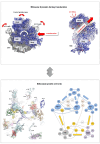


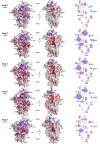
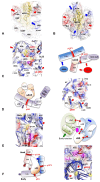
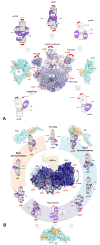
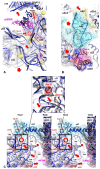
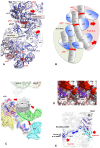
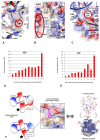
Similar articles
-
Structural insights into pre-translocation ribosome motions.Pac Symp Biocomput. 2011:205-11. doi: 10.1142/9789814335058_0022. Pac Symp Biocomput. 2011. PMID: 21121048 Free PMC article.
-
Ribosome reactivation by replacement of damaged proteins.Mol Microbiol. 2010 Feb;75(4):801-14. doi: 10.1111/j.1365-2958.2009.07002.x. Epub 2009 Dec 4. Mol Microbiol. 2010. PMID: 19968789
-
Measuring the dynamics of E. coli ribosome biogenesis using pulse-labeling and quantitative mass spectrometry.Mol Biosyst. 2012 Oct 30;8(12):3325-34. doi: 10.1039/c2mb25310k. Mol Biosyst. 2012. PMID: 23090316 Free PMC article.
-
The ribosome in focus.Cell. 2001 Mar 23;104(6):813-6. doi: 10.1016/s0092-8674(01)00278-1. Cell. 2001. PMID: 11290319 Review. No abstract available.
-
Atomic structures of the eukaryotic ribosome.Trends Biochem Sci. 2012 May;37(5):189-98. doi: 10.1016/j.tibs.2012.02.007. Epub 2012 Mar 20. Trends Biochem Sci. 2012. PMID: 22436288 Review.
Cited by
-
The Expanding Universe of Extensions and Tails: Ribosomal Proteins and Histones in RNA and DNA Complex Signaling and Dynamics.Genes (Basel). 2025 Jan 1;16(1):45. doi: 10.3390/genes16010045. Genes (Basel). 2025. PMID: 39858592 Free PMC article. Review.
-
Implication of ribosomal protein in abiotic and biotic stress.Planta. 2025 Mar 11;261(4):85. doi: 10.1007/s00425-025-04665-6. Planta. 2025. PMID: 40067484 Review.
References
-
- Melnikov S., Ben-Shem A., Garreau de Loubresse N., Jenner L., Yusupova G., Yusupov M. One core, two shells: bacterial and eukaryotic ribosomes. Nat. Struct. Mol. Biol. 2012; 19:560–567. - PubMed
-
- Bashan A., Yonath A. Correlating ribosome function with high-resolution structures. Trends Microbiol. 2008; 16:326–335. - PubMed
-
- Steitz T.A. A structural understanding of the dynamic ribosome machine. Nat. Rev. Mol. Cell Biol. 2008; 9:242–253. - PubMed
-
- Schmeing T.M., Ramakrishnan V. What recent ribosome structures have revealed about the mechanism of translation. Nature. 2009; 461:1234–1242. - PubMed
MeSH terms
Substances
Grants and funding
LinkOut - more resources
Full Text Sources

